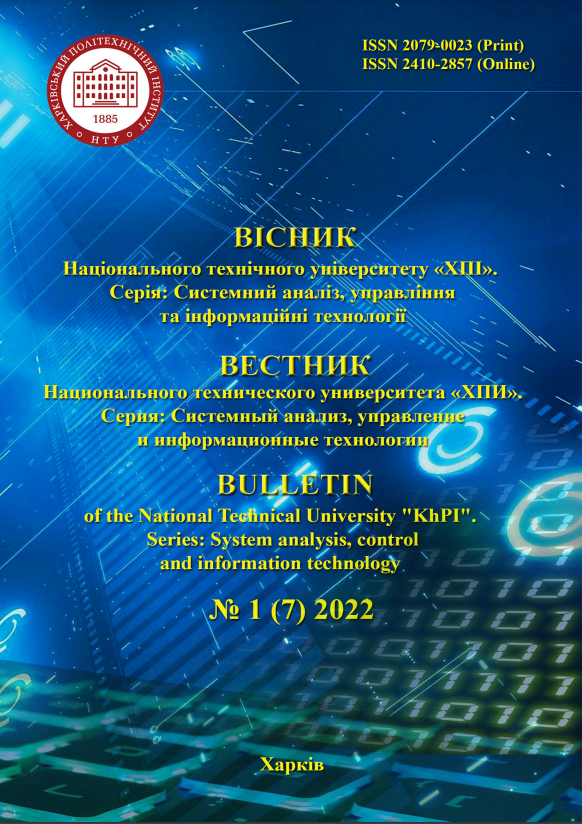IDENTIFICATION OF LINEAR DYNAMIC SYSTEMS IN THE ENVIRONMENT OF POLYNOMYAL SIGNALS
DOI:
https://doi.org/10.20998/2079-0023.2022.01.03Keywords:
parametric identification, linear dynamical system, polynomial signal, vector-matrix representation of a polynomial, linear system of equationsAbstract
A method for the structural and parametric identification of one-dimensional linear stationary dynamic systems, represented by differential "inputoutput" constraint equations, is proposed. The method is focused on both active and passive experiments. The method is based on a polynomial
representation of the input and output signals of the identified dynamic system. A compact vector-matrix representation of polynomials is proposed,
which makes it possible to find the forced component of the solution of linear differential equations as a result of performing simple linear algebraic
operations. The vector-matrix representation of polynomials made it possible to quite simply solve the problem of inversion of linear dynamical
systems and the problem of compensating the measured perturbation. The issues of representing time signals in polynomial form are not considered in
this paper. Based on the obtained linear representation of a one-dimensional dynamic system, which links the parameters of the input and output
signals with the parameters of the differential equation of the identified dynamic system mathematical model, a linear system of algebraic equations for
unknown coefficients of the differential process equation is obtained. In the general case, the resulting system belongs to the class of overdetermined
systems, and therefore its solution can be obtained by the least-square technique and is reduced to finding a pseudoinverse matrix. A block diagram of
software for solving the problem of structural and parametric identification in the environment of polynomial signals is proposed. The algorithm
includes the procedure of comparing the results of numerical simulation of the identified model with the output experimental signal and correcting the
structure of the model based on the results of the comparison.
References
Eykhoff P. System Identification: Parameter and State Estimation. New York, John Wiley & Sons, 1974. 555 p. (Rus. ed.: Eykhoff P. Osnovi identifikatsii sistem upravleniya. Moscow, Mir Publ., 1975. 686 p.).
Sage A. P., Melsa J. L. System Identification. New York, Academic Press, 1971. 221 p. (Rus. ed.: Seidzh E. P., Melsa Dzh. L. Identifikatsiya sistem upravleniya. Moscow, Nauka Publ., 1974. 248 p.).
Deich A. M. Metodi identifikatsii dinamicheskikh obektov [Methods for identifying dynamic objects]. Moscow, Energiya Publ., 1979. 240 p.
Ljung L. System Identification: Theory For the User. 2nd ed. PTR Prentice Hall, Upper Saddle River, 1999. 609 p. (Rus. ed.: Ljung L. Identifikatsiya sistem: Teoriya dlya polzovatelya. Moscow, Nauka Publ., 1991. 431 p.).
Yegupov N. D., Pupkov K. A., ed. Statisticheskaya dinamika i identifikatsiya sistem avtomaticheskogo upravleniya. Metodi klassicheskoi i sovremennoi teorii avtomaticheskogo upravleniya. T. 2 [Statistical dynamics and identification of automatic control systems. Methods of classical and modern theory of automatic control. Vol. 2]. Moscow, MGTU im. N. E. Baumana Publ., 2004. 640 p.
Vasilev S. N. Teoriya i primenenie logiko-upravlyaemikh sistem [Theory and application of logic-controlled systems]. Trudi 2-j Mezhdunar. konf. "Identifikatsiya sistem i zadachi upravleniya" (SICPRO’03). 29–31 yanvarya 2003 g. [Proceedings of the 2nd Intern. conf. "Identification of systems and control tasks" (SICPRO'03). January 29–31, 2003]. Moscow, IPU RAN Publ., 2003, pp. 23–52.
Avdeenko T. V., Kargin S. A. O globalnoi identifitsiruemosti dinamicheskikh modelei [On the global identifiability of dynamical models]. Trudi 2-j Mezhdunar. konf. "Identifikatsiya sistem i zadachi upravleniya" (SICPRO’03). 29–31 yanvarya 2003 g. [Proceedings of the 2nd Intern. conf. "Identification of systems and control tasks" (SICPRO'03). January 29–31, 2003]. Moscow, IPU RAN Publ., 2003, pp. 155–214.
Zatuliveter Yu. S. Kompyuternaya informatsiya v modeli ischisleniya drevovidnikh struktur [Computer information in the model of calculus of tree structures]. Trudi 2-j Mezhdunar. konf. "Identifikatsiya sistem i zadachi upravleniya" (SICPRO’03). 29–31 yanvarya 2003 g. [Proceedings of the 2nd Intern. conf. "Identification of systems and control tasks" (SICPRO'03). January 29–31, 2003]. Moscow, IPU RAN Publ., 2003, pp. 1935–1949.
Petrovich V. N. Identifikatsiya parametrov matematicheskikh modelei dinamicheskikh sistem upravleniya [Identification of parameters of mathematical models of dynamic control systems]. Iskusstvennii intellect [Artificial intelligence]. 2011, no. 4, pp. 343– 349.
Shumikhin A. G., Boyarshinova A. S. Algoritm vibora strukturnikh parametrov iskusstvennoi neironnoi seti i obema obuchayushchei viborki pri approksimatsii povedeniya dinamicheskogo obekta [Algorithm for choosing the structural parameters of an artificial neural network and the size of the training sample when approximating the behavior of a dynamic object]. Kompyuternie issledovaniya i modelirovanie [Computer research and modeling]. 2015, vol. 7, no. 2, pp. 243–251.
Kutsenko A., Kovalenko S., Tovazhnyanskyy V. Inversion of dynamic systems for certain classes of signals. CEUR Workshop Proceedings. 2019, vol. 2353, pp. 391–401.
Gantmakher F. R. Teoriya matrits [Matrix theory]. Moscow, Fizmatlit Publ., 2010. 558 p.
Downloads
Published
How to Cite
Issue
Section
License
LicenseAuthors who publish with this journal agree to the following terms:
- Authors retain copyright and grant the journal right of first publication with the work simultaneously licensed under a Creative Commons Attribution License that allows others to share the work with an acknowledgement of the work's authorship and initial publication in this journal.
- Authors are able to enter into separate, additional contractual arrangements for the non-exclusive distribution of the journal's published version of the work (e.g., post it to an institutional repository or publish it in a book), with an acknowledgement of its initial publication in this journal.
- Authors are permitted and encouraged to post their work online (e.g., in institutional repositories or on their website) prior to and during the submission process, as it can lead to productive exchanges, as well as earlier and greater citation of published work (See The Effect of Open Access).


